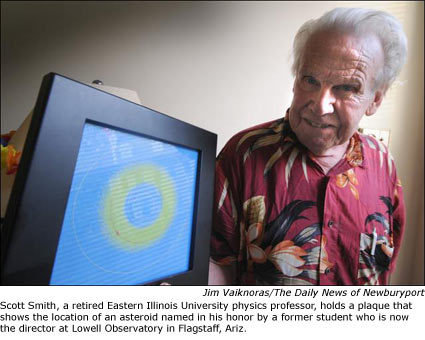Retired Professor Has An Asteroid All His Own
Jul-07-2008Reprinted by permission from the The Daily News of Newburyport, Newburyport, Massachusetts.
 Few people in this world can look up into the sky at night knowing that somewhere, floating above them, there is a astronomical object with their name on it.
Few people in this world can look up into the sky at night knowing that somewhere, floating above them, there is a astronomical object with their name on it.
Paul McCartney, Sean Connery and John Cleese can. Lou Gherig, Mark Twain and Beethoven could, as well.
Now, Newburyport resident and retired Eastern Illinois University physics professor Scott Smith can add his name to the list of asteroids, joining the ranks of famous astronomers, actors, singers, novelists and philosophers that also have planetesimals orbiting with their namesake.
"It really surprised me," said Smith, 85. The retired professor received a letter in April notifying him that a former student, Robert Millis, had discovered an asteroid and named it in Smith's honor.
"He was an outstanding teacher," said Millis, now the director of Lowell Observatory in Flagstaff, Ariz. He said that Smith made physics interesting and exciting, even though it is extremely complex for many people.
To thank the doctor for the significant influence he had on the astronomer's career, Millis had asteroid (132792) Scottsmith officially sanctioned by the International Astronomical Union.
"The influence he had on me sent my life in a completely different direction," Millis said. "Had I not encountered him, I would have never pursued a career in astronomy." Millis explained that originally he had planned to become a high school teacher, but Smith encouraged him to attend graduate school at the University of Wisconsin where he obtained his doctorate in astronomy.
"I felt very honored by his feeling that I had contributed so much to his life," Smith said.
The asteroid Scottsmith, which circles the Sun at a distance of three astronomical units (three times the distance from the Earth to the sun), is located in the asteroid belt, a ring of frozen bits of rock located between Mars and Jupiter thought to be remnants of a planet, or pieces of a large astronomical body that never formed.
Millis explained that once an astronomical body is discovered, a series of observations must be done in order to establish the body's orbital path is stable, and that the object cannot stray from its orbit and become "lost." Once the calculations show a consistent path, the International Astronomical Union approves a number and title for the body, allowing the discoverer to present an option for a name.
"This was an opportunity at long last to honor Dr. Smith in an appropriate and lasting way," Millis said.
During his 40-year stay at Eastern Illinois University, Smith was a physics lecturer as well as a faculty sponsor for the Student Senate. Smith said that he encountered Millis both in class and in the senate, their similar interests eventually establishing a friendship.
Smith, originally from Richmond, Va., began his career in physics at Cornell in 1940, where he completed his bachelor's degree in physics and chemistry in 1943. Smith then worked in the physical optics division at a naval research laboratory in Washington, D.C., from 1943 to 1945, where, among other things, he studied how to detect ships with infrared. These detectors later became integral parts to space satellites.
But Smith's work at the naval lab only fed his interest in physics even more, convincing him to return to Cornell and work toward a doctorate degree. In 1951, Smith received his doctorate in physics from Cornell. He finally settled in as a professor at Eastern Illinois University from 1953 until 1990.
Since finishing his career at EIU, Smith has worked his way back to the east coast to be closer to his daughter. Despite his move away from the school, however, Smith continues to hold a steady interest in physics and quantum mechanics. He explained that he remains intrigued by the origin and formation of the asteroid belt and the topic of space exploration and discovery.
And while Smith repeated several times that the recognition was "no big deal," it's hard to hide his excitement as he holds the plaque with a diagram and statistics of the asteroid's location.
"I have never encountered an individual so capable of teaching physics," Millis said. "He is remarkable."
Written by Melanie Graham, staff writer for The Daily News of Newburyport